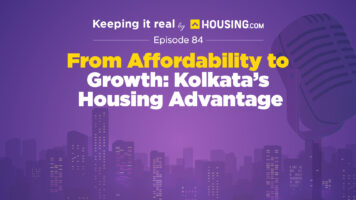It’s easy to overlook the buildings around us. They form the skyline, house our businesses, and keep our lives moving. But behind the glass façades and steel frames, buildings are also responsible for nearly 40% of global energy-related carbon emissions. The solution isn’t always building new. In fact, the biggest gains may come from looking inward at what we’ve already built.
That’s where green retrofitting steps in.
Retrofitting, which essentially meant upgrading existing buildings to improve energy and resource efficiency, used to be considered a cost center or compliance measure. But today, it is becoming a strategic move for developers, occupiers, and investors alike. And increasingly, it is where the smartest capital is going.
The case for retrofit is no longer just environmental
Globally, most of the buildings we’ll occupy in 2050 are already standing. In India, over 60% of the Grade A commercial office stock across our top seven cities needs upgrades to meet modern sustainability standards, according to JLL. This represents a ₹450 billion investment opportunity with tangible economic payoffs.
What do those payoffs look like?
- Energy and cost savings: Green retrofits can slash energy use by up to 50%, reducing operational costs significantly.
- Higher rentals and valuations: Upgraded buildings command a rental premium of 15 to 30%, and in some markets like Mumbai, this can rise to 40 to 50%.
- Better occupancy and tenant retention: Companies chasing net-zero targets are gravitating toward greener spaces. In a competitive leasing market, that matters.
- Lower maintenance and resilience risks: Efficient systems break down less often, and climate-adaptive upgrades (think insulation, smart cooling, or flood resistance) prepare assets for the future.
And that is just the start.
Retrofitting isn’t just green. It’s smart strategy.
Let’s be clear. Sustainability has shifted from “nice to have” to business-critical. Multinational occupiers want buildings that reflect their ESG values. Regulators are tightening efficiency norms. Investors are pricing in climate risk. In fact, buildings without sustainable upgrades could soon face what is known as a “brown discount,” a drop in value for failing to meet energy performance thresholds.
But it is not just about avoiding risk. There is a strong upside to getting ahead of the curve.
LEED-certified buildings have reported nearly 20% lower maintenance costs compared to typical commercial buildings. Separately, green retrofits have been shown to reduce operational costs by around 10% within the first year alone. Beyond cost savings, studies by U.S. Green Building Council highlight that green buildings improve indoor air quality, which can lead to fewer sick days, reduced stress, and higher productivity. These outcomes aren’t just environmental or health wins. They have measurable business value.
Circularity is the next frontier
There is growing momentum globally to build not just greener but smarter and more circular. That means reusing materials during retrofits, reducing construction waste, and selecting components that can be recycled at the end of life.
Consider this. Retrofitting instead of redeveloping outright produces less than half the carbon emissions. In the UK, the Entopia Building reused 3.8 tonnes of steel and diverted over 5,000 items from landfill. It is an example of how circular retrofits can cut environmental impact while maintaining modern performance standards.
For India, where materials and logistics form a major chunk of construction costs, circular retrofits also offer a way to reduce reliance on virgin resources and create local green jobs.
Financing the retrofit shift
One common hesitation around retrofitting is cost. It is true that deep energy retrofits can require significant upfront investment. But access to financing is improving.
Green bonds, sustainability-linked loans, and energy performance contracts are all emerging as viable pathways. As of 2023, global issuance of sustainability-linked bonds reached $66 billion. In India, green finance is gaining traction, with regulators encouraging ESG disclosures and sustainable investing frameworks.
For developers, that means a retrofit-ready portfolio could be more attractive to institutional investors.
Data, technology, and the talent factor
Retrofitting today is not what it used to be. Technology has changed the game.
Digital twins, smart meters, and AI-driven diagnostics allow owners to track building performance in real time. This helps not just in monitoring but also in improving how buildings use energy, water, and space over time. Deloitte’s 2025 CRE Outlook found that 41% of surveyed leaders plan to invest in digital twins to model and optimize retrofits.
But technology is only as good as the people using it. The growing retrofit economy needs skilled professionals, from envelope engineers and MEP specialists to sustainability consultants and project managers. Companies that invest in upskilling their workforce are not just meeting demand. They are creating a competitive advantage.
Retrofitting as brand and culture strategy
Here is a surprising takeaway from several studies: people want to work in green buildings.
And not just because they look good.
Spaces that prioritize air quality, natural light, and thermal comfort tend to keep employees healthier and more productive. In a world where talent chooses employers based on values as much as pay, a retrofitted, high-performance building can say a lot about a company’s culture.
It is no wonder then that 50% of Indian organizations surveyed in JLL’s Future of Work report are willing to pay a premium for sustainable office spaces. It is also why smart occupiers are signing green leases that link rental terms to building performance.
Final thought: Retrofitting is the future, but it needs to start now
The conversation around green buildings is no longer limited to new construction. The opportunity, and the necessity, is with the buildings we already have.
Retrofitting is not just about reducing emissions. It is about staying relevant, attracting capital, boosting returns, and meeting the expectations of modern tenants, employees, and regulators. It is about building a resilient, future-fit real estate ecosystem.
The next five years will define whether India’s built environment can pivot fast enough. Businesses that act early will not only benefit from first-mover advantage but also help shape a more sustainable urban future for all.







